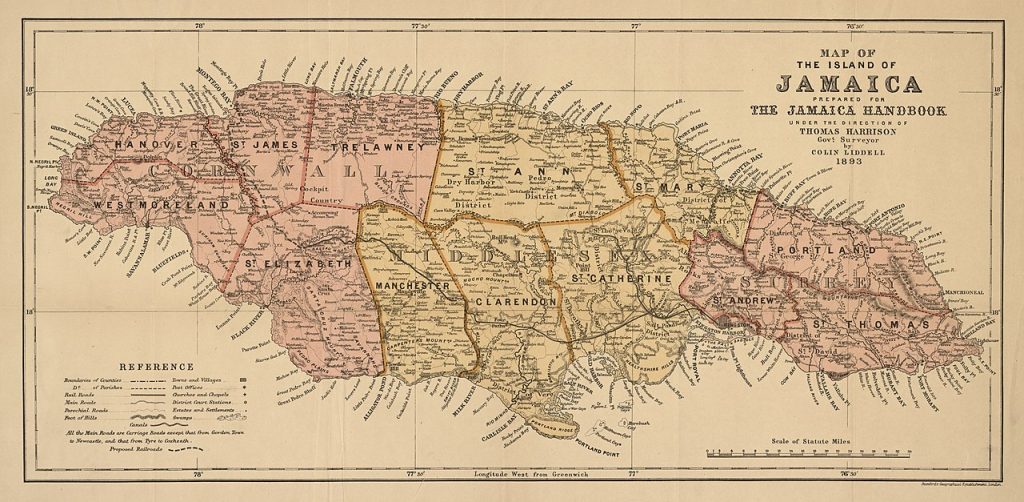When Jamaica was first colonised by the Spanish within the early sixteenth century, its administration regarded very totally different from the orderly parishes we all know in the present day. The island, generally known as Xaymaca by the Taíno, was beneath Spanish management from 1494 till 1655, when it was captured by the British. This early interval laid the muse for the island’s administrative buildings, which might evolve considerably beneath English affect.
Spanish Rule: Unfastened Administration and Regional Divisions
Spain’s curiosity in Jamaica started with Christopher Columbus’s arrival in 1494, however it wasn’t till 1509 that the Spanish started formal settlement. The capital was initially established at Seville la Nueva or New Seville on the north coast in 1510, earlier than being moved to St. Jago de la Vega (now Spanish City) in 1535 as a consequence of well being issues and higher defensibility.
Below Spanish management, Jamaica was sparsely populated and by no means developed into a significant colony like Cuba or Hispaniola, nor did the Spanish implement a strong administrative construction. As an alternative, the island was divided into free geographical areas, together with Northside, Bluefields, Guanaoboa, Withywood, St. Jago de la Vega, Liguanea, Yallahs, and Morant. These had been extra indicative of huge landholdings and settlements than formal governmental divisions.
A number of place names from this period—reminiscent of Yallahs, Liguanea, and Guanaboa—replicate a mix of Spanish and Taíno influences, and lots of survive in fashionable Jamaica.
The British Take Over: 1655 and the Seeds of Change
In 1655, a British expedition led by Admiral William Penn and Basic Robert Venables captured Jamaica from the Spanish through the Anglo-Spanish Battle. Whereas lots of the Spanish settlers fled to Cuba, the British inherited a colony with minimal infrastructure and a small European inhabitants.
Decided to make Jamaica a profitable colonial holding, the British launched extra structured programs of governance. Considered one of their first acts was to divide the island into administrative models, progressively shifting from navy rule to civil administration.
By the early 1660s, beneath the governorship of Sir Thomas Modyford (1664–1671), Jamaica’s first formal parishes had been established. These had been each ecclesiastical and civil divisions, reflecting the shut relationship between church and state in English governance. Initially, seven parishes had been created within the extra settled south and central components of the island:
- Clarendon
- St. John
- St. Andrew (then known as Liguanea)
- St. Catherine
- Port Royal
- St. David
- St. Thomas (later St. Thomas-in-the-East)
Parishes had been used to organise native governance, tax assortment, and church actions. Over the next many years, because the British expanded their management throughout the island, extra parishes had been added. By 1683, Jamaica had 15 parishes, overlaying many of the island.

From Seven to Twenty-Two to Fourteen: How the Parish System Advanced
As British settlement unfold and the island’s financial system—particularly sugar plantations—grew, so did the variety of administrative divisions. The parish system expanded considerably over the following two centuries:
- 1693: Kingston separated from St. Andrew, turning into its personal parish.
- 1703: Westmoreland fashioned from the western a part of St. Elizabeth.
- 1723: Portland created from components of St. George and St. Thomas-in-the-East; Hanover break up from Westmoreland.
- 1770: Trelawny fashioned from components of St. James and St. Ann.
- 1814: Manchester created from sections of Clarendon, Vere, and St. Elizabeth.
- 1841: Metcalfe Parish established from components of St. George and St. Mary.
By 1841, the island had reached its peak variety of 22 parishes.
Nonetheless, by the mid-Nineteenth century, the colonial authorities noticed the necessity to streamline native governance. On 23 April 1867, the Law to Reduce the Number of Parishes was handed, decreasing the quantity from 22 to 14. A number of smaller or much less economically viable parishes had been absorbed into bigger ones:
- Vere was merged into Clarendon
- St. Dorothy, St. John, and St. Thomas-in-the-Vale had been merged into St. Catherine
- St. David was absorbed by St. Thomas
- St. George merged into Portland
- Metcalfe grew to become a part of St. Mary
- Port Royal was divided between Kingston and St. Andrew
This consolidation created the 14 parishes that exist in the present day, which had been additional grouped into three counties—Surrey, Middlesex, and Cornwall—for administrative and judicial functions.

Parishes and British Colonial Identification
The names of Jamaica’s parishes provide perception into colonial identification and energy. Many had been named after British monarchs, governors, their relations, or locations in England. As an illustration:
- St. Catherine was named for Queen Catherine of Braganza, spouse of Charles II.
- Clarendon was named after the Lord Chancellor, Edward Hyde, Earl of Clarendon.
- St. Elizabeth honoured the spouse of Governor Thomas Modyford.
By the mid-18th century, Jamaica’s parishes and counties had been absolutely established, forming a framework for native governance, taxation, and church affairs that formed the colony effectively into the twentieth century.
Complicated & Layered Colonial Legacy
Although the Spanish left behind comparatively few administrative buildings, their early settlements and place names stay etched into the island’s geography. The British, alternatively, reworked Jamaica’s governance solely—introducing programs that fashioned the premise for the fashionable state. The association and governance of Jamaica’s parishes, formalised beneath British rule, continues to function the muse of native administration in Jamaica, with boundaries, names, and county affiliations rooted in a fancy and layered colonial previous.

